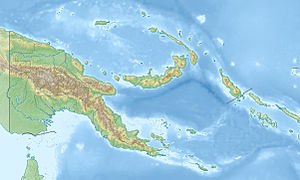Hansa Bay
| Hansa Bay Hansabucht (former name) |
||
|---|---|---|
| Waters | Bismarcksee | |
| Land mass | New Guinea | |
| Geographical location | 4 ° 10 '12 " S , 144 ° 52' 12" E | |
|
|
||
| width | approx. 7 km | |
| depth | approx. 5 km | |
| Islands | Laing Island (within the bay), Manam (13 km northeast) | |
Hansa Bay ( English ; formerly German Hansabucht ) is a bay on the northwest coast of New Guinea in the Bogia district , about 15 km northwest of the district capital Bogia, in the Madang province .
The bay belongs to the Bismarcksee and is about 7 km long and about 5 km wide. Within the bay is the small island of Laing Island. The so-called Hansa-Point ( location ), a small peninsula, borders the bay to the southeast .
About 13 km from Hansa Bay is the volcanic island of Manam .
history
Colonial times
The bay was discovered by Jules Dumont d'Urville in 1827 . It was given the German name Hansabucht in 1886 by Georg von Schleinitz , at that time the first governor of the German New Guinea Company to whose area of influence the bay belonged. The bay later became part of the German colony of New Guinea . Nothing is known about the use of the bay as a port or the surrounding land for plantations at this time. After the First World War , the Kaiser-Wilhelms-Land and with it the Hansa Bay fell to Australia as a trust territory .
Second World War
During the Pacific War , the army of the Japanese Empire occupied northern New Guinea from 1942 to 1945. During the Battle of New Guinea , Hansa Bay was an important base for the Japanese Combined Fleet and a transit base between the Wewak region and the bases further south-east, such as Finschhafen .
The airfields and military camps of Awar and Nubia were also in the vicinity of the bay.
On June 12, 1944, the 35th Battalion of the Australian Army reached Hansa Bay and pushed the Japanese defenders inland to the Sepik . After the bases and camps were abandoned by the Japanese, the area around Hansa Bay was the largest ammunition depot that had been captured in the New Guinea campaign at the time.
The fierce sea and aircraft fighting in the region during World War II resulted in a large number of wrecks that can still be found. This includes around 35 shipwrecks that are popular with wreck divers .
The wrecks in the area include:
- PT-speed boat USS PT-337 , a motor torpedo boat of the United States Navy
- Sydney Maru (also known as Shishi Maru ): an Imperial Japanese Navy cargo ship
- a B-25D Mitchell bomber of the United States Army Air Forces (serial number: 41-30345, tail: "Y")
- a United States Army Air Forces B-24J-35 bomber (serial number: 42-73338)
- a Bell P-39 Airacobra fighter aircraft of the United States Army Air Forces
literature
- Keyword Hansabucht. In: Heinrich Schnee (Ed.): German Colonial Lexicon. Quelle & Meyer, Leipzig 1920, Volume II, p. 37 ( online ).
- Bruce T. Swain: A Chronology of Australian Armed Forces at War 1939-45. Allen & Unwin. 1st edition, 2001, ISBN 978-1865-0835-20 .
Web links
- Chapter VI - The Westward Drive Along New Guinea from the Reports of General Douglas MacArthur : The Campaigns of Gen. MacArthur in the Pacific - Vol. 1.
- List of the wrecks lying in the area around the Hansa Bay English-language private homepage with some historical pictures.
